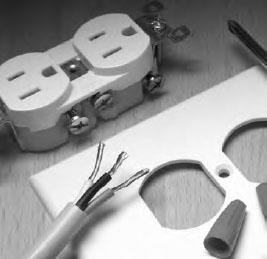Outlets have two slots, one longer than the other, and a “D”-shaped hole. The contacts in the shorter slot are connected to a black wire. This is the “hot” connection that carries the 120 volts. The contacts in the longer slot are connected to a white wire, called the neutral wire. The white wire is connected to ground in the electric distribution box. Thus there is a potential difference of 120 volts across the two contacts. The third hole is attached to a green wire that is at ground potential. Why do you need two connections at the ground potential? Because when the appliance plugged in draws current, there is current through both the black and white wires. Each wire has resistance, so there will be a voltage drop across the white wire, and it will be above ground potential at the outlet. While this voltage will be small, it could be dangerous. The green wire, which carries no current, will remain at ground. It can be connected to the metal case of the appliance, assuring that the case will remain at ground potential.

When installing an electrical outlet, note that the green wire (okay, you can’t tell in this black and white photo, but it is there!) is the grounding wire, which must be attached to the grounding contact on the outlet.

